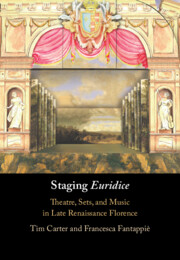91 results
The effectiveness of cognitive behavioural therapy for depression in women with breast cancer: a systematic review and meta-analysis
-
- Journal:
- Behavioural and Cognitive Psychotherapy / Volume 52 / Issue 4 / July 2024
- Published online by Cambridge University Press:
- 23 February 2024, pp. 394-413
- Print publication:
- July 2024
-
- Article
- Export citation
2 - ‘…e poi le parole’
- from Part I - The Italian Foundations
-
-
- Book:
- The Cambridge Companion to Seventeenth-Century Opera
- Published online:
- 08 December 2022
- Print publication:
- 22 December 2022, pp 22-38
-
- Chapter
- Export citation
Money, Accounts, Measurements, Dates, and Time
-
- Book:
- Staging 'Euridice'
- Published online:
- 11 November 2021
- Print publication:
- 02 December 2021, pp xxiv-xxviii
-
- Chapter
- Export citation
Contents
-
- Book:
- Staging 'Euridice'
- Published online:
- 11 November 2021
- Print publication:
- 02 December 2021, pp v-vi
-
- Chapter
- Export citation
3 - Euridice in Performance
-
- Book:
- Staging 'Euridice'
- Published online:
- 11 November 2021
- Print publication:
- 02 December 2021, pp 130-197
-
- Chapter
- Export citation
Abbreviations
-
- Book:
- Staging 'Euridice'
- Published online:
- 11 November 2021
- Print publication:
- 02 December 2021, pp xxix-xxix
-
- Chapter
- Export citation
4 - Conclusions and Consequences
-
- Book:
- Staging 'Euridice'
- Published online:
- 11 November 2021
- Print publication:
- 02 December 2021, pp 198-216
-
- Chapter
- Export citation
Works Cited
-
- Book:
- Staging 'Euridice'
- Published online:
- 11 November 2021
- Print publication:
- 02 December 2021, pp 229-241
-
- Chapter
- Export citation
Appendix I: - Documents
-
- Book:
- Staging 'Euridice'
- Published online:
- 11 November 2021
- Print publication:
- 02 December 2021, pp 217-228
-
- Chapter
- Export citation
Preface
-
- Book:
- Staging 'Euridice'
- Published online:
- 11 November 2021
- Print publication:
- 02 December 2021, pp xi-xx
-
- Chapter
- Export citation
2 - Staging and Sets
-
- Book:
- Staging 'Euridice'
- Published online:
- 11 November 2021
- Print publication:
- 02 December 2021, pp 64-129
-
- Chapter
- Export citation
Sources, Transcriptions, and Translations
-
- Book:
- Staging 'Euridice'
- Published online:
- 11 November 2021
- Print publication:
- 02 December 2021, pp xxi-xxiii
-
- Chapter
- Export citation
1 - Euridice in Context
-
- Book:
- Staging 'Euridice'
- Published online:
- 11 November 2021
- Print publication:
- 02 December 2021, pp 1-63
-
- Chapter
-
- You have access
- HTML
- Export citation
Copyright page
-
- Book:
- Staging 'Euridice'
- Published online:
- 11 November 2021
- Print publication:
- 02 December 2021, pp iv-iv
-
- Chapter
- Export citation
Index
-
- Book:
- Staging 'Euridice'
- Published online:
- 11 November 2021
- Print publication:
- 02 December 2021, pp 242-252
-
- Chapter
- Export citation
Tables
-
- Book:
- Staging 'Euridice'
- Published online:
- 11 November 2021
- Print publication:
- 02 December 2021, pp x-x
-
- Chapter
- Export citation
Illustrations
-
- Book:
- Staging 'Euridice'
- Published online:
- 11 November 2021
- Print publication:
- 02 December 2021, pp vii-ix
-
- Chapter
- Export citation

Staging 'Euridice'
- Theatre, Sets, and Music in Late Renaissance Florence
-
- Published online:
- 11 November 2021
- Print publication:
- 02 December 2021
Defect analysis of star defects in GaN thin films grown on HVPE GaN substrates
-
- Journal:
- Microscopy and Microanalysis / Volume 27 / Issue S1 / August 2021
- Published online by Cambridge University Press:
- 30 July 2021, pp. 916-917
- Print publication:
- August 2021
-
- Article
-
- You have access
- Export citation
An ultra-wide bandwidth (704 to 4 032 MHz) receiver for the Parkes radio telescope
-
- Journal:
- Publications of the Astronomical Society of Australia / Volume 37 / 2020
- Published online by Cambridge University Press:
- 08 April 2020, e012
-
- Article
-
- You have access
- HTML
- Export citation




